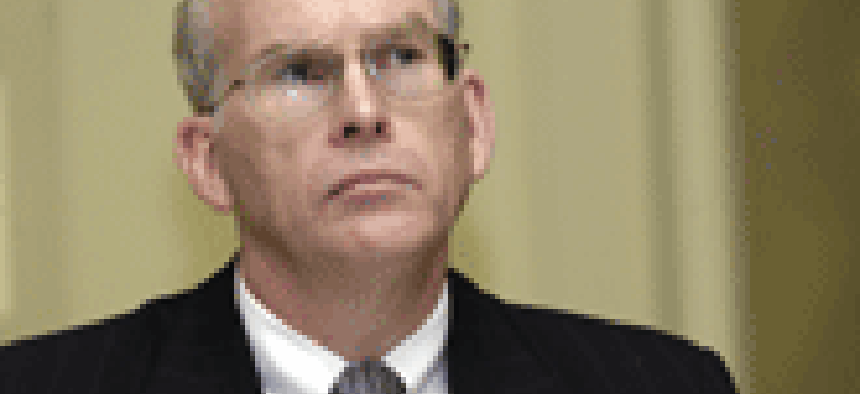Chief Information Officer 2001 Pittsburgh Fairfax, Va. Wife, Deborah, a teacher at Bishop Ireton High School, Alexandria, Va.; sons, Kevin, 25, and Ryan, 22 Fitness (jogging, weights, biking), reading, gardening and landscaping "Connect the Dots ? To Become an Impact Player" by Dick Lynch Bachelor's degree in mathematics from Duquesne University; master of science degree in computer engineering from Case Western Reserve University; master of business administration degree from Virginia Polytechnic Institute and State UniversityGilligan: IT worked. IT was clearly a primary enabler for both Afghanistan and Iraq conflicts. Global networks provided sufficient bandwidth to permit rapid exchange of information; Web-based tools for planning and tracking worked; GPS-derived systems permitted very precise position location and targeting as well as superior situation awareness that confounded the enemy. Interoperability between the Air Force, Army and Navy permitted synergy on the battlefield, and limited confusions and conflicts while permitting enormous firepower to be used with confidence.Gilligan: I would agree substantially with that, but I think we ought to be careful that we don't oversimplify some of the technology, including the information technology that was used. An awful lot of what we used was commercially available technology, and probably the percentage of what we used was a higher percentage of commercially available technology than in any other situation.But there are some things that we also did that are military-unique applications that you won't find elsewhere. In those cases, many of those were built on building blocks. I wouldn't want to leave the impression that we just go out to eBay or Dell or others and order a bunch of commercial stuff and glue it together, and that's what we got.When you get into the warfighting areas, when you're talking about, for example, sending precision positioning coordinates, whether it's our special forces guys on the ground, or combat search and rescue, or a target, [or] to an aircraft, there are pieces of that that are not commercially available. Those are relatively unique. But they're leveraging [open] protocols, such as Internet protocol. That would be my only caveat.Gilligan: That is a loaded question. NMCI was the Navy's approach to deal with a couple of needs. To this point, the Air Force has met those needs through other methods. In the future, we'll likely use increasingly contracted support. But I think we're unlikely to bundle everything in the scale that the Navy did with NMCI, in part because that, from out vantage point, has proven to be a little bit of a disadvantage because it's so big. What the Navy has done in terms of consolidating all of its networks and all of its computers, we've done that as well; we've just not done it through a single big contract. We're well along and nearing completion of that, establishing common sets of service levels, etc., common standards. So we have been doing that in parallel, as has the Army, by the way. So there are a lot of things.Do we like what the Navy is doing? Apart from the fact that it's all one big contract, yeah, there are a lot of good things about that. As you may know, they're struggling on some areas ? it's gone a lot slower than they would like, the contractor is having problems, etc. ? so that is why I am caveating the statement. Would we do it exactly that way? No. Do we plan in the future to outsource increasingly some of our infrastructure? Yes. In fact, I'm looking for us to begin that dialogue with industry in earnest about nine months from now.Gilligan: Many technology needs parallel industry: global connectivity using standards-based common infrastructure; online, self-service business applications; reduced cost of ownership. Those that pertain to our air and space warfighting mission tend to be unique, [such as] linkage to airborne, space platforms; some of our security requirements ? encryption, strong authentication, equipment hardening for certain environments ?while others parallel industry; mission planning, rehearsal, etc.Gilligan: IT has been the key to much of the Air Force transformation. Examples include limiting the number of people we deploy by using IT to "reach back" to folks at home station; using older platforms, such as the B 52 bomber, a platform designed to deliver nuclear weapons, to perform precision delivery of conventional weapons in a mission called close air support, where the weapons are delivered within hundreds of yards of friendly forces. Gilligan: That they share our focus on integration, compliance with recognized standards and innovation.For the complete interview with Air Force CIO John Gilligan, go to and type 121 in the Quickfind box.
1670 Air Force Pentagon
Washington, DC 20330-1670
(703) 545-6700
www.af.mil
Founded: Sept. 17, 1947
Secretary: James Roche
Chief of staff: Gen. John Jumper
Active duty: 370,000
Guard and Reserve 180,000
Civilian employees: 160,000
What it does: The Air Force provides for national defense through air and space power.
Major components: There are 66 major Air Force bases in the United States (including the Air Force Academy) and 14 overseas. There are numerous guard and reserve bases nationwide. There are nine major commands, including Air Combat Command, Space Command and Pacific Air Forces.
Number crunching
Air Force budget:
2004 request: $93.5 billion
2003: $87.2 billion
IT budget
2004 request: $6.4 billion
2003: $5.8 billion
The fiscal 2004 budget request is divided into four categories: people, readiness, infrastructure and modernization. The largest amount of the request, 34 percent, is earmarked for quality-of-life initiatives. Modernization is getting the second-largest chunk at $31.2 billion. This includes $2.2 billion for science and technology. Readiness is to get 28 percent, or $25.8 billion, including $14.1 billion for flying operations, $1.8 billion for space operations and $9.6 billion for mission-support functions.
John Gilligan
Henrik G. de Gyor

